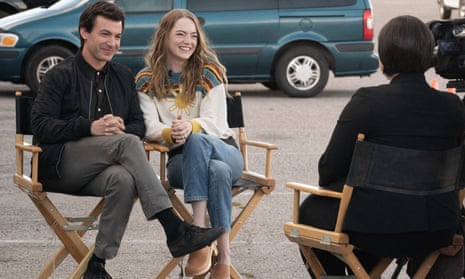The Curse is highly uncomfortable viewing. I would go so far as to say it is almost uniquely unpleasant to sit through each of its 10 episodes, most of which hit the hour-long mark. To say that I enjoyed it, as an entertainment experience, would be a lie. It is horrible and excruciating. Yet it is also inventive, provocative, oddly mesmerising and quite unlike anything else you will see on television this year. It is almost guaranteed to be loved and loathed in equal measure.
I must be a TV masochist, because I love it. Created by Nathan for You and The Rehearsal’s Nathan Fielder, who is no stranger to awkwardness, and Uncut Gems’ co-director Benny Safdie, who is no stranger to stress, the awkward, stressful The Curse follows a married couple, Asher (Fielder) and Whitney Siegel (Emma Stone), as they attempt to launch their reality TV show, provisionally entitled Flipanthropy. The concept is a Queer Eye-type series in which they do “good deeds” for the largely uninterested people of the city of Española, New Mexico. These good deeds also happen to incorporate marketing for the Siegels’ ecohome business, which is built on a model of buying cheap properties and flipping them for great profit, boosted by their attempts to gentrify the area with whitewashed minimalist coffee shops, denim stores and a lot of pottery made by Indigenous and local artists.
This is an open goal for satire and the show hits its initial targets convincingly. Asher and Whitney attempt to convince themselves of their own benevolence, though the foundations of their business are soon revealed to be as exploitative as anything they claim to be pushing against. A less ambitious show might stop here and explore performative good deeds as its central premise, but The Curse unfurls into far weirder territory, gobbling up ever greater themes as it progresses.
Gentrification and the white saviour complex are only a starting point. It also takes on the art world and the selling of trauma, ecological sainthood and climate-change individualism, and the myth of upward mobility. It is also a vicious satire of television and entertainment, which might be why it is so difficult to watch as a series: it makes its point on a palpable level. The Siegels are desperate to get their TV pilot off the ground, and the recipients of their “generosity” are pawns, all manipulated by their gung ho creep of a producer Dougie (Safdie). Dougie claims to have bullied the oblivious Asher when they were younger, and his previous reality show pilot is so awful that the idea will probably appear on a streaming service in real life in the very near future.
As the Siegels strive for their real-estate business and TV careers to take off, they meet obstacles: reporters who dig around for the facts beneath the facade they present to their audience, and the curse of the title, which may or may not be supernatural. Asher is urged to give a child, who is selling drinks in a car park, cash for the cameras, but he only has a $100 bill. He hands it over, and after they get the shot, asks for it back, so he can get change and give her $20 instead. The child, quite rightly, curses him. This unfolds in an exquisitely long, unbearably strained series of exchanges about money that stretch the idea of awkwardness until it breaks and forms what might be a new form of horror. That’s to say nothing of the penis chat with the in-laws, in all of its gruesome glory.
These showpiece moments of ultra cringe appear as the show’s terrible peaks, but they emerge from a general atmosphere of creeping dread that does not relent. There is a droning, atmospheric soundtrack that barely lets up. Characters are often framed through the scratched and dirty glass of closed windows, which make it feel claustrophobic and as if we are illicitly spying on their innermost thoughts.
after newsletter promotion
Fielder’s Asher is more outwardly self-serving and tightfisted. Stone’s Whitney hides it behind a pinched smile, paralysed by self-consciousness and a fear of “getting it wrong”. Their own eco-friendly home is a certified passive house (a real certification scheme, though the name is put to comic use here), but they have turned it into a gilded cage, covered in reflective glass which is entirely unnecessarily for its sustainability model. It becomes a kind of pressure cooker, decorated with art that has been meticulously assessed for its “authenticity”.
The Curse can test the patience. Scenes go on for an obscene amount of time, and at their frequent worst, elicit an uneasiness that makes some of The Office’s most awkward moments seem like an episode of The Repair Shop. But it is exhilaratingly tense, it ends magnificently and I found it impossible to look away.
